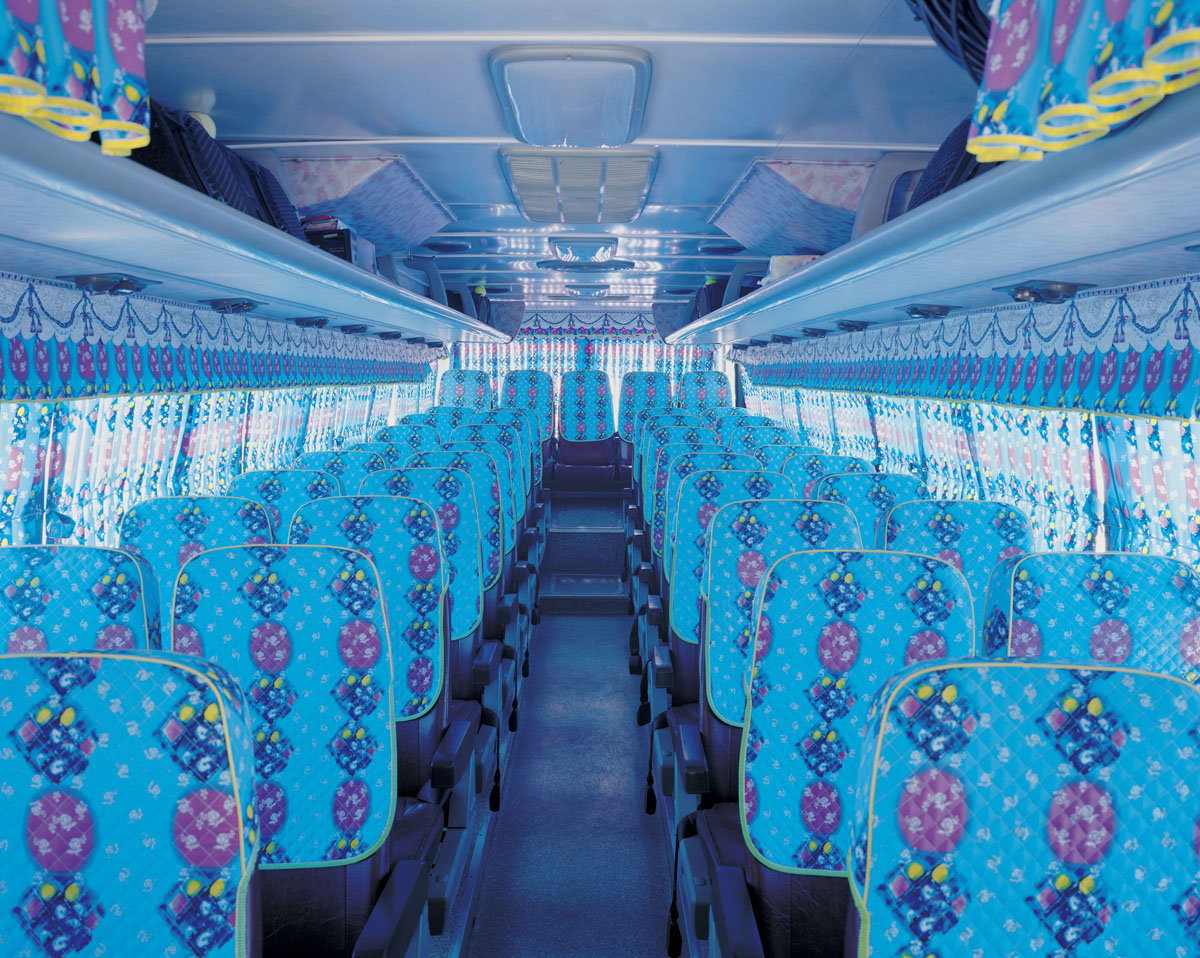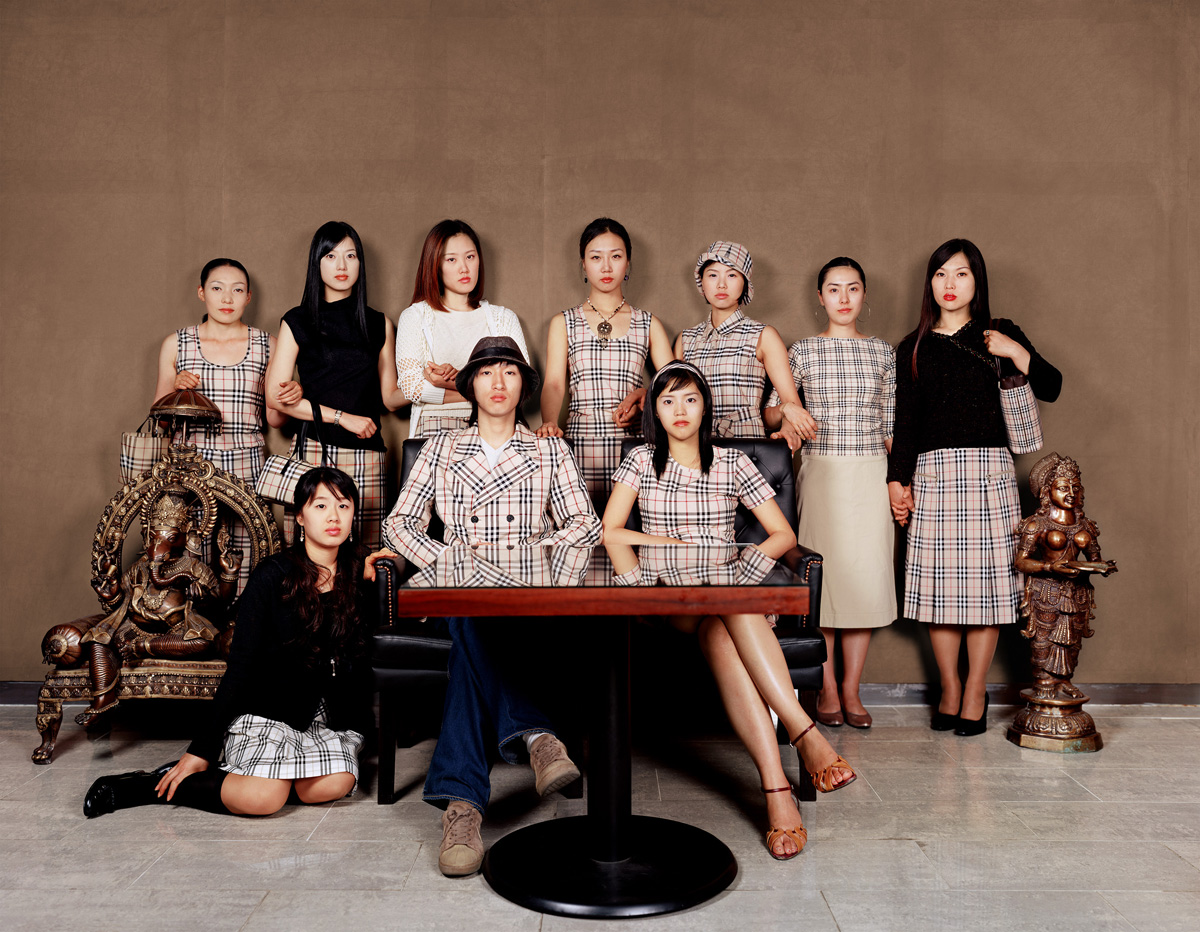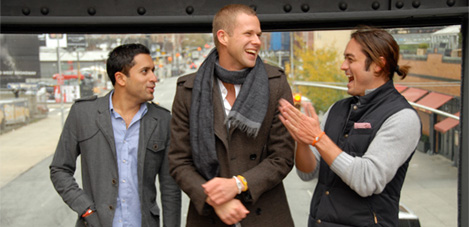CHAOTIC HARMONY OPENS AT SANTA BARBARA MUSEUM OF ART JULY 3, 2010 KOO, Sungsoo, Tour Bus, 2005, from the series Magical Reality (2005–6). Chromogenic photograph. The Museum of Fine Arts, Houston 
SBMA Presents the First Survey Exhibition of Korean Photography in U.S. “Chaotic Harmony” Includes Work of 40 Contemporary Artists
The first major exhibition in the United States of photographs made by contemporary Korean artists presently living in Korea, Chaotic Harmony: Contemporary Korean Photography opens a window to the dynamic photographic scene in the Republic of Korea, known in the West as South Korea. Bringing together work by 40 contemporary photographers, this presentation of 42 large-scale images surveys the range of contemporary issues through the themes of land and sea; urbanization and globalization; family, friends, and memory; identity: cultural and personal; and anxiety. Within the exhibition, two distinct generations of Korean artists are represented: those born in the mid-1950s and 1960s, during a succession of military dictatorships when the country was still largely agrarian, and those born in the 1970s, predominantly in urban areas and who came into maturity in the new democratic era which began in 1987. Co-organized by Karen Sinsheimer, Curator of Photography at the Santa Barbara Museum of Art and Anne Wilkes Tucker, The Gus and Lyndall Wortham Curator of Photography at the Museum of Fine Arts, Houston, this groundbreaking exhibition is not a presentation on “Koreanness,” although issues of cultural and personal identity are strong components. Rather, it is an attempt to identify Korea as a source of complex and stimulating visual ideas expressed through the medium of photography. Land and Sea Most of the work represented in the “Land and Sea” section of the exhibition was created by the first generation of Korean artists who traveled abroad for their graduate educations and brought their new ideas back to dramatically effect photographic styles in Korea. Nevertheless, many of them remained tied to Korean landscapes and traditions while embracing new aesthetic ideas. The extraordinarily beautiful land and seascapes in this section celebrate Korea’s surrounding oceans and the forests that cover large sections of its mountainous terrain. In addition, these photographers often explore religious practices that are primarily tied to nature. BAE Bien-u’s Kyung ju (1985) from the series Sonamu (which translates to “sacred pine grove”), documents mist-shrouded pine trees surrounding Gyeongiu, the ancient city of the Shilla kingdom (A.D. 668–935). KIM Young-sung’s untitled photograph (2005) from the Dolman series, shows a man standing atop one of Korea’s 50,000 dolmans (or ancient tombs). Over 60 percent of the world’s 80,000 dolmans are located in Korea. Gap-Chul Lee has documented shamanism (as well as Buddhism) in Korea for decades, but most specifically in his series Conflict and Reaction (1990–2001).
Urbanization and Globalization An ancient civilization, South Korea has recently transformed into one of the world’s major global economies. Three-fourths of the population is categorized as urban, with half living in the country’s six major cities. Seoul is the world’s fourth largest metropolitan area. This section of the exhibition responds to the shift of the population from rural to city living, and the entrance of Korea on to the world stage. Young-Joon CHO’s Usual & Circle—Seoul Namdaemun, Rho Gwang-hyo (2005) is a diptych: the image on the left presents an urban area teeming with stores, advertisements, people, and traffic, while the image on the right isolates a woman who we would not have otherwise noticed in the larger view of the city. Her expression of emotional distress is consistent with all the isolated figures in the series. Ahn Sekwon documented Seoul’s rapid physical changes by photographing one particular neighborhood of the Weolgok-dong section of Seoul in 2005, 2006, and 2007 as the old homes are destroyed to make room for new high rises. The resulting triptych dramatically conveys the destruction of the modest-scale homes to make way for the towering scale of a modern city. Family, Friends, and Memory This section of the exhibition reflects the tensions in shifting societal values and practices as Korea continues its rapid growth. Traditionally, families followed Confucian norms: the father was the respected head of household and made decisions for his wife and children, financially supporting the family and arranging schooling and marriages. Social values have changed with increasing awareness of Western cultures through travel and the importation of Western products and media. Also with dramatic urban growth, came shifts from homes to crowded high rises, the entrance of women into the workforce, and other changes. Sunmin LEE’s photograph, Lee, Sunja’s House #1—Ancestral Rites (2004), portrays traditional values playing out in a modern setting: the men and boys of a family conduct traditional rituals in one room while the women watch from the doorway. Sanggil KIM’s off-line_Burberry internet community (2005) depicts a modern phenomenon: people who met over the internet, united by a common passion, in this case, that of wearing Burberry Check (registered as a trademark of the Burberry brand) and enjoying an “off-line” get-together. 
Image above: KIM, Sanggil, off-line_Burberry internet community, 2005 from the series off-line (2005), Chromogenic photograph. Museum purchase with funds provided by PhotoFutures, Santa Barbara Museum of Art.
Identity: Cultural and Personal Between 1910 to 1945, Japan annexed Korea and systematically attempted to eradicate Korean culture and identity, for example, by banning Korean literature and language from schools. Only six years after World War II, Korea was devastated by the Korean War. This section of Chaotic Harmony investigates what it means to be Korean today after this disruptive history. Some artists, such as Bohnchang KOO, seek to reclaim past cultural history, by photographing treasured and uniquely Korean items such as Celadon—the main type of ceramic produced in ancient Korea and generally exalted as Korea’s most significant artistic legacy. Jungjin Lee in term photographs native crafts from Korean folk culture. Exploring more personal aspects of identity is Yeondoo JUNG’s Bewitched #2, a diptych juxtaposing images of the same teenager, mopping the floor of a Baskin Robbins in her day job and exploring the Artic regions in her dream job; and Hyo Jin IN’s Violet # 01 from the High School Lovers series (2007), which portrays an openly lesbian couple. Anxiety The “Anxiety” section of Chaotic Harmony investigates the constant tension provoked by strained relations and the potential of a violent outbreak between North and South Korea. Jung LEE’s Bordering North Korea, #2 (2005), from her 2005-2008 series of the same title, offers a view of North Korea seen from China and them superimposes over it an accompanying text chosen from the set phrases that North Koreans are allowed to say to the few foreigners who gain access to the country, such as “Our country is the paradise of the people.” She wants the viewer to experience both the beauty of the land and the palpable repression evident in the political slogans. Seung Woo Back references the subliminal fear of an attack from North Korea by staging “invasions” of toy soldiers that march across a family’s yard and up their wall to the kitchen window ledge, presumably unbeknownst to the person whose silhouette is visible though the window. Catalogue An illustrated catalogue of the same title accompanies Chaotic Harmony, co-published by the Santa Barbara Museum of Art and The Museum of Fine Arts, Houston, and distributed by Yale University Press. The catalogue presents one of the first overviews of the artists, subjects, and themes in contemporary Korean photography, with scholarly essays by Tucker and Sinsheimer; a chronology of post-World War II developments by noted photographer and curator Bohnchang Koo; an exhibition checklist; and brief biographies of the artists, compiled by MFAH photography curatorial assistant Natalie Zelt. The catalogue is available in the SBMA Museum Store. The Santa Barbara Museum of Art is a privately funded, not-for-profit institution that presents internationally recognized collections and exhibitions and a broad array of cultural and educational activities as well as travel opportunities around the world. Santa Barbara Museum of Art, 1130 State Street, Santa Barbara, CA. Open Tuesday - Sunday 11 am to 5 pm. Closed Monday. 805.963.4364 www.sbma.net
TIME FOR ART by Bonnie Carroll  Summer is a time for fun, and the creators of some of the most popular fun watches have outdone themselves for this vacation filled time of year by designing extremely light weight, space conscious, high style sport/dress watches in exciting and dramatic designs and colors. The original Silicon watch has been elaborated on and is available in a variety of sexy hues. The company also has matching belts, wallets, USB memory keys and more in a rainbow of vibrant colors. Summer is a time for fun, and the creators of some of the most popular fun watches have outdone themselves for this vacation filled time of year by designing extremely light weight, space conscious, high style sport/dress watches in exciting and dramatic designs and colors. The original Silicon watch has been elaborated on and is available in a variety of sexy hues. The company also has matching belts, wallets, USB memory keys and more in a rainbow of vibrant colors.
Too Late Aurora watches literally light up the night by glowing in the dark. These adorable, colorful and easy to use watches were designed to look like bracelets for people who like cool presentations for day or night; light of the day and energy of the night! They are anti-scratch, water-proff and quite unique. Ali Fogazzi, who added Italian style & cool to a line of great products available at www.toolate.com has created the must have accessory for european youth, which has created enormous sales in the US. These adorable, colorful and easy to use watches were designed to look like bracelets for people who like cool presentations for day or night; light of the day and energy of the night! They are anti-scratch, water-proff and quite unique. Ali Fogazzi, who added Italian style & cool to a line of great products available at www.toolate.com has created the must have accessory for european youth, which has created enormous sales in the US.  Another delightful little gem of a watch is the Rumba Time Another delightful little gem of a watch is the Rumba Time watch, which comes in a graceful ladies watch design, is easy to read, and is available in a variety of hot colors. They also offer a thick banded more sporty looking product. watch, which comes in a graceful ladies watch design, is easy to read, and is available in a variety of hot colors. They also offer a thick banded more sporty looking product.
 Rumba was created by Joe Anto, Drew Deters and Jay Hartington as a perfect fun, stylish and affordable solution to owning a chic watch that could go anywhere with ease. For product information visit: www.rumba.com. Rumba was created by Joe Anto, Drew Deters and Jay Hartington as a perfect fun, stylish and affordable solution to owning a chic watch that could go anywhere with ease. For product information visit: www.rumba.com.
BETWEEN HERE AND THERE: Passages in Contemporary Photography METROPOLITAN ART MUSEUM Exhibition Dates: July 2, 2010 - February 13, 2011
Exhibition Location: Joyce and Robert Menschel Hall for Modern Photography, second floor Themes of dislocation and displacement in contemporary photography will be explored in The Metropolitan Museum of Art's forthcoming exhibition in the Joyce and Robert Menschel Hall for Modern Photography. Drawn almost entirely from the Museum's collection, Between Here and There: Passages in Contemporary Photography on view July 2, 2010 through February 13, 2011, will feature 22 artists whose photographic works convey a sense of a rootless or unfixed existence. In the 1960s and 1970s, photography was often embraced by artists who had abandoned conventional art media and who were more interested in creating a work of art that took place over a period of time, in a serial progression, or in a fleeting gesture. The individual painting or sculpture was deemed insufficient to represent the fragmented experience that characterizes the modern world; thus artists showed how a work of art could take the form of a walk (Richard Long), a 20-foot-long book (Ed Ruscha), or a series of postcards outlining the precise time that the artist got up each day (On Kawara). Since the 1980s, however, the more conventional practice of creating a carefully executed, singular photograph has regained prominence in contemporary art. Works by Rineke Dijkstra, Thomas Struth, and Weng Fen embody a belief in photography's traditional powers of description, while reflecting feelings of dislocation in our newly global society. The exhibition also will include works by: Vito Acconci, Doug Aitken, Darren Almond, Lothar Baumgarten, Matthew Buckingham, Valie Export, Felix Gonzalez-Torres, Svetlana Kopystiansky, Bruce Nauman, Dennis Oppenheim, Allen Ruppersberg, Fazal Sheikh, Erin Shirreff, Robert Smithson, Anne Turyn, and Jeff Wall. The first half of the exhibition shows how artists in 1960s and 1970s, working in the context of Minimal and Conceptual art, were drawn to photography for its differences from traditional art media: it was low-tech, easily reproducible, and not considered a valuable art object. Photography was also enlisted to document ephemeral works of art. Bruce Nauman and Vito Acconci, for instance, created performances that focused on the actions and movements of their bodies in space, and captured these works in photographs and videos. Other artists, such as Robert Smithson, chose to work directly in the landscape—often in distant or inaccessible locations—and their "Earthworks" could generally be seen only through photographs. Smithson is best known for his landmark Spiral Jetty (1970) in the Great Salt Lake, Utah. For an early experiment in his Mirror Displacements series of photographs, Smithson placed small mirrors into snow drifts on the roof of his apartment building. Through dizzying shifts in scale, the artist's 1969 study transforms a corner of his Manhattan roof into an Alpine landscape. A student of Anthony Caro, British artist Richard Long was well versed in the reductive quality of geometric abstraction, but sought to make his works even more simple and wedded to life. He would go for solitary walks in the countryside, and at a particular place he would create elemental forms such as a line, X, or circle by walking over the ground to leave a temporary imprint. Long's photograph County Cork, Ireland (1967)—in which a circle seems to hover over the grass like a flying saucer—is thus an imprint of an imprint, creating a holistic relationship between the concept, the action of the body, and the site of his gesture. For her series Body Configurations, the Austrian artist Valie Export had herself and female colleagues photographed in local streets, as they contorted their bodies to mimic the harsh geometries of the city. Encirclement (1976) shows a woman lying in the street, her body elongated and arched to follow the bright red curve the sidewalk. The photograph reintroduces the human body into abstraction in an intimate yet public gesture. Beginning in the 1980s, there was a renewed interest in photography's historical genres and recommitment to technical skill and visual fidelity, as seen in Rineke Dijkstra's portraits. Geopolitical displacement and cultural migration are referenced in one of Dijkstra's most important bodies of work to date: her photographs of a Bosnian refugee girl, Almerisa. Between Here and There will feature four portraits of Almerisa that Dijkstra made between 1994 and 2000, beginning at an asylum seekers' center in the Netherlands. Eight photographs from this series of 11 works were acquired recently by the Museum. In both photographs and films, Doug Aitken explores the ways in which perception is transformed by our global, technology-driven existence. Aitken's photograph Passenger (1997), taken from the window of an airplane in flight, shows another plane flying in parallel in the remote distance, illuminated by the sun setting on a slanted horizon. Aitken references sensations of being adrift in mid-air and of "two ships passing"—paths that do not quite connect, despite their proximity to each other. Chinese artist Weng Fen explores a young generation poised at a transitional moment between China's traditional rural society and a quickly burgeoning urbanism. Bird's Eye View: Haikou V (2002) shows a woman—perhaps an outsider or a new arrival to the city—perched on an old wall, looking toward the new skyscrapers on the horizon, but not fully occupying the space of the past or the future. This work is part of a group of recent gifts and promised gifts of contemporary Chinese photographs to the Museum. The exhibition comes full circle with a recently acquired video by Erin Shirreff. Roden Crater (2009) takes as its subject artist James Turrell's legendarily inaccessible and still unfinished celestial observatory carved out of a 400,000-year-old extinct volcano. Shirreff's mesmerizing fixed-camera view of the distant "Earthwork" shows an improbable succession of slow-moving climactic and light effects on the crater, creating a haunting meditation on the never-ending quest for resolution in life and in art. Between Here and There: Passages in Contemporary Photography is organized by Douglas Eklund, Associate Curator in the Department of Photographs.
ANCIENT ARTIFACTS DISCOVERED DURING EXCAVATIONS IN NORTHERN ISRAEL
 More than a hundred 3,500-year-old intact religious artifacts and other items were discovered last week during excavations led by the Israel Antiquities Authority in a natural hollow in the bedrock at Tel Qashish near Yokneam in northern Israel. More than a hundred 3,500-year-old intact religious artifacts and other items were discovered last week during excavations led by the Israel Antiquities Authority in a natural hollow in the bedrock at Tel Qashish near Yokneam in northern Israel.
Among the discovered items is a religious vessel used for burning incense, a sculpted face of a woman that was broken apart from a cup, goblets and bowls with high bases and tableware. A cache of the artifacts, such as a storage container for precious oils, was believed to have been brought from Mycenae, supporting evidence of the ancient trade relations with Greece.
 "In this period, before the Bible, the children of Israel were still in Egypt or the desert, and it would appear that the vessels were used in a pagan cult that worshiped idols," says Dr. Edwin van den Brink, Israel Antiquities Authority. "During this period, it was customary that each city had a temple of its own where special religious vessels were used." "In this period, before the Bible, the children of Israel were still in Egypt or the desert, and it would appear that the vessels were used in a pagan cult that worshiped idols," says Dr. Edwin van den Brink, Israel Antiquities Authority. "During this period, it was customary that each city had a temple of its own where special religious vessels were used."
The Israel Antiquities Authority will present these artifacts to the public in a special exhibition commemorating the 20th anniversary of its establishment this year.
For more information about travel to Israel, visit www.goisrael.com.
“Diana — The People’s Princess” Makes Royal Debut at the New Branson Exhibition Center World-class exhibition features an impressive collection of priceless dresses and hundreds of authentic artifacts celebrating the life of Princess Diana The Branson Exhibition Center announced today the grand opening of its first world-class exhibition, Diana — The People’s Princess, for a special limited engagement. Already experienced by adoring audiences around the world, this blockbuster exhibition opened Thursday, July 1, 2010 – just in time to commemorate Diana’s 49th birthday. Centrally located at the former Roy Rogers Museum on Green Mountain Drive, Diana — The People’s Princess is a fascinating, full-scale exhibition which gives an intimate glimpse at the life of Princess Diana— as told through her own personal objects and stories from every day life. A Royal Treat Comes to Branson Displayed in a stunning 26,000-sq. ft. setting, this exhibition showcases an impressive collection of Diana’s own dresses-- which she auctioned for charity weeks before her untimely death-- as well as hundreds of artifacts and historic mementos relating to her life in a world-class, museum-quality, interactive experience. From handwritten notes to intriguing insight into her life as a member of the British royal family, this special engagement offers a rich, personal perspective and celebrates the life of one of the most iconic and inspirational individuals of our age. Beginning in the exhibition center’s 300-seat theater, attendees are given a dramatic introduction to the rest of the exhibition with a 15-minute video which follows the journey of a girl from the English countryside, whose life would ultimately play out on the world stage and make her a household name on seven continents. Following the video introduction, the self-guided tour takes guests through a series of themed rooms, each dedicated to a different period in Diana’s life. Featured areas include: - Diana’s Childhood home
- The Royal Engagement and Wedding
- Diana, The Princess of Wales
- Diana’s Favorite Role: As “Mum” to William and Harry
- The Princess of Style
- Humanitarian Work and Building a Legacy
Diana — The People’s Princess at the Branson Exhibition Center is being jointly produced locally by the experienced exhibition team of Tony Doblin, President & COO, Exhibition Dynamix and Maureen Dunkel, President & CEO, Exhibition Experience, LLC. “This exhibition gives audiences a rare, in-depth glimpse into one of history’s most fascinating individuals as told through her own story and cherished possessions,” said Tony Doblin, President & COO, Exhibition Dynamix. “I believe visitors and residents of Branson will warmly embrace an attraction of this caliber, and it will be positively received as the first world-class exhibition at the new Branson Exhibition Center.” “With the passing of time, it has been proven that Diana was not merely a celebrity who rose to command a global stage simply because she married her prince,” said Maureen Dunkel, President & CEO, Exhibition Experience and owner of the world’s largest private collection of Diana’s dresses. “Diana embodied the magical notion of fantasy… a fantasy which ultimately collided with the realities of life and that collision forged a relatability that cemented her in the hearts and minds of millions worldwide. It is my sincere hope visitors to this fascinating exhibition will leave with a deep understanding of why Diana was and remains The People’s Princess.” Ms. Dunkel, who founded The People’s Princess Charitable Foundation, Inc., is instrumental in sharing with worldwide audiences her collection of priceless gowns from the late Princess Diana, which she had purchased anonymously just weeks before Diana’s untimely death. The exhibition in Branson will showcase an impressive selection from Ms. Dunkel’s collection, and will be updated with additional dresses throughout the run of the exhibition. The exhibition currently features several of Diana’s most well-known dresses, including the exquisite pink “India” dress which Diana wore during her 1992 State Tour of India, as well as a dramatic black silk velvet dress she wore in her official royal portrait. Influenced both by the outpouring of public grief following the Princess tragic death and the Princess’ dedication to global humanitarian activities, Ms. Dunkel played a key role in the decision to share the dresses with the public for their sentimental enjoyment and appreciation of their historical importance. Additionally, the exhibition also features more than a thousand objects relating to the life of Diana, including hundreds of authentic artifacts and historical mementos from the extensive collection of John Hoatson. Among the many objects, visitors will be able to see a slice of Charles and Diana’s actual wedding cake (in a special presentation box signed by her brother), as well as hand-written personal notes from Diana and family members, and fanciful genuine articles of Diana’s clothes, including “sport socks,” a shirt and sarong worn by Diana. This exhibition comes to Branson after a very successful engagement at Downtown Disney at the Walt Disney World Resort complex.
|





